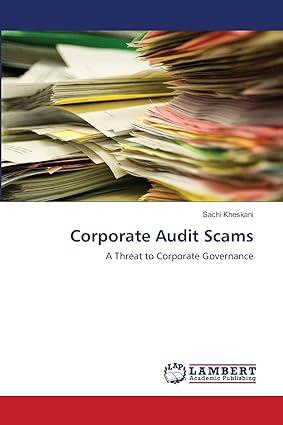Question
Y ou can access the book on Chegg.com ID= petterbuilt200@yahoo.com PW = General1123 Section 13: Chapter 13 - Overhead and Marketing Variances Chapter 14 -
You can access the book on Chegg.com ID= petterbuilt200@yahoo.com PW = General1123
Section 13: Chapter 13 - Overhead and Marketing Variances Chapter 14 - Management Accounting in a Changing Environment Study Activities Y
Please read and study Chapters 13 and 14 in your Zimmerman text. Assignment 14 Case Analysis: The case studies, assigned in this course, are complex situations relating to accounting for decision making. The text simplifies the explanations and examples to enable a learner to grasp the concept.
The solution must fit the case and must be vigorously supported. The problem statement, analysis, selected solution, and especially the justification of the selected solution, are all critical elements in the case method. There are no short cuts to case presentations but a formalized methodology that enables the case presenter the optimal way to solve the case problem.
Complete and submit Case Study 14-1: Global Oil, starting on page 649 of your text.
Cases
Case 141: Global Oil12
Page 650In 1995, Global Oil Corporations Marketing and Refining (M&R) Division was the fifth largest U.S. refiner with 7,700 Global-branded service stations selling about 23 million gallons per day, or 7 percent of the nations gasoline. All the service stations are company owned. In 1990, M&R ranked last among its peers in profitability and was annually draining $500 million of cash from the corporation.
In 1993, M&R reorganized from a centralized functional organization (Refineries, Transportation, Warehousing, Retail, and Marketing) into 17 geographic business units (sales and distribution) and 14 service companies. The functional organization was slow to react to changing market conditions and the special customer needs that differed across the country. The new decentralized organization was designed to better focus on the customer. New marketing strategies could be better tailored to local markets by giving local managers more decision-making authority.
A new corporate strategy to focus on the less price-sensitive customer who would not only buy Global gas but also shop in its convenience gas-store outlets was implemented simultaneously with the reorganization. Globals new strategy was to redesign its convenience stores so they would become a destination stop," offering one-stop shopping for gas and snacks.
The old organization used a variety of functional measures: manufacturing cost, salNew technology such as fiber optics causes relative prices of competing technologies to changees margins and volumes, and health and safety metrics. After changing its corporate strategy and organizational structure, M&R decided to change its performance metrics and began investigating the balanced scorecard.
Balanced scorecard (BSC) at M&R
M&R formed project teams of managers to design performance metrics for its operations. Thirty-two different metrics were identified. These included Financial (ROA, cash flow, volume growth, etc.). Customer (share of segment, mystery shopper, etc.). Internal (safety incidents, refinery ROA, inventory level, etc.), and Learning (strategic skills accumulation, quality of information system, etc.). The mystery shopper is a third-party vendor who purchases gas and snacks at each station monthly. During each visit, the mystery shopper rates the station on 23 items related to external appearance, rest rooms, and so forth. A brochure describing the BSC was prepared and distributed to M&Rs 11,000 employees in August of 1994. Extensive meetings with employees explained the new metrics and the BSC concept.
Compensation plans
All salaried employees of M&R received up to a 10 percent bonus if Global ranked first among its seven competitors on ROA and earnings per share (EPS) growth. In addition to this existing plan, a new program was added that awarded bonuses of up to 20 percent to managers. The size of the bonus depends on the average performance of three factors:
Globals competitive ranking on ROA and EPS growth.
M&Rs balanced scorecard metrics.
Own business units balanced scorecard.
In 1995, M&R generated more income per barrel of oil than the industry average, and its ROA exceeded the industrys average.
Required:
Critically evaluate M&Rs implementation of the balanced scorecard. Identify any strengths and weaknesses of the program.
Was the adoption of the balanced scorecard at M&R responsible for the turnaround in its financial performance?
Step by Step Solution
There are 3 Steps involved in it
Step: 1

Get Instant Access to Expert-Tailored Solutions
See step-by-step solutions with expert insights and AI powered tools for academic success
Step: 2

Step: 3

Ace Your Homework with AI
Get the answers you need in no time with our AI-driven, step-by-step assistance
Get Started


